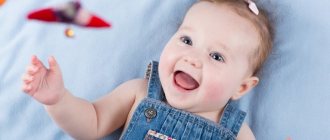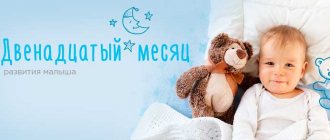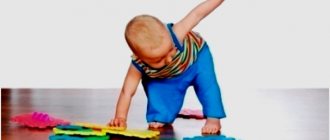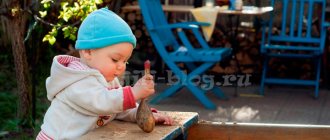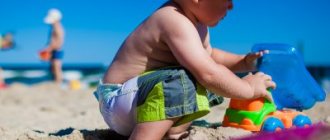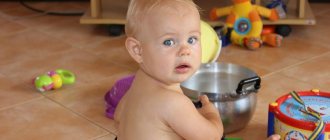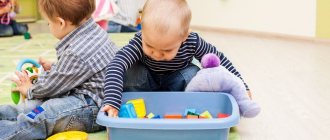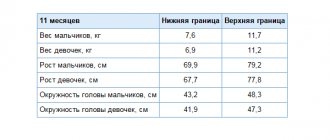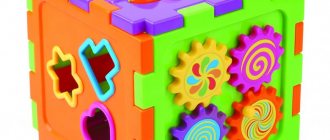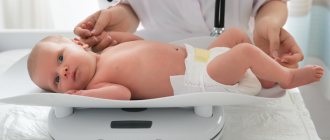Babies at the age of 2 years and 9 months reach the peak of motor activity. The need for movement does not allow the child to sit still for at least half an hour. Little fidgets have time everywhere. Often the result of their hectic activity is broken toys or broken dishes. However, the troubles caused by the baby only indicate his normal development.
See, a detailed calendar of child development from birth to 3 years by month
Physiological characteristics of a child at 2 years 9 months
The baby is not growing as actively as in the first year of life.
| BOYS | GIRLS | |
| Average height, cm | 90-97,4 | 90-95,5 |
| Average weight, kg | 13,2-15,6 | 12,9-14,9 |
| Head circumference, cm | 46,4-50,6 | 45,4-49,7 |
By this age, the child has grown all his milk teeth, and the body is being rebuilt to a new level.
Speech development, communication and communication.
- Comments on everything he sees and hears. He doesn’t speak clearly yet, but it’s already clear, using adjectives: “fingers are dirty.”
- Constructs phrases of 2-3 words: “Mom, get up!” “Tanya, look – fish!” “Feed me, mom!”
- Understands a short life story by ear.
- He recites poems with his mother, adding to the last phrase:
Dropped the teddy bear on the floor
They tore off the
bear's paw...
The owner abandoned the bunny
,
a bunny was left in the rain...
My phone . Who's speaking? Elephant!…
Mom was washing clothes in the kitchen, and the cat was sitting and looking at her...
- From the picture he understands a simple plot.
- The vocabulary consists of 50 legible words. He understands everything, but he cannot speak everything yet.
- I like to hear how complex words sound.
- Shows interest in peer games. Observes and repeats their movements, uses speech.
- Toddlers of the same age can smile at each other and immediately push and quarrel over a toy, taking it from each other. They continue to play side by side, but not together.
- Emotional contact with parents and loved ones is still important for a child.
On topic: Chicken. Logorhythmics.
Physical and mental development of a child at 2 years and 9 months
| Neuropsychic development | 1. The child is familiar with primary colors and body parts. 2. Actively draws, sculpts, makes crafts. 3. When repeating the same events, he systematizes the ongoing processes and successfully fits himself into this system, for example, he takes part in small theatrical scenes with pleasure. 4. Masters role-playing games and is actively involved in their planning. 5. The baby’s need to receive answers to questions that he asks more and more often increases. 6. The child expands his social circle and engages in conversations with strangers (for example, in a clinic or store). 7. little songs and poems well |
| Speech development | The child quickly expands his vocabulary and constructs sentences more correctly. His need to speak is growing every day, words fly out of the baby at the speed of a machine gun burst. The baby uses sentences of 3 or more words, confidently answers questions based on the picture with familiar characters (who is drawn, what is he doing?). The baby actively conducts a dialogue with the children during the game, saying hello and saying “bye” or “goodbye.” |
| Household skills |
|
| Motor development | 1. The kid knows how good to ride a tricycle. 2. Assembles complex structures from the constructor. 3. Jumps and runs well. 4. Climb stairs without using railings. 5. Jumps from a small height (from a step or curb) without any problems. 6. Walks confidently on tiptoes , maintaining balance. 7. Flips through book pages without any problems . 8. Can walk along an inclined board without the help of adults. 9. Knows how to use scissors , at first he randomly cuts paper, then learns to cut out simple shapes. |
| Social development (relations with others) | The child develops an individual attitude to each family member, so he communicates differently, for example, with his mother and grandmother. When playing independently, children imitate their gender, daughter - to mom, and son - to dad. The feeling of attachment to family weakens a little . Children, as before, are worried when they leave, but quickly calm down. Kids actively imitate each other . If one person starts jumping, all the children repeat the same after him. |
| Experience of the unconscious | When some event or object related to birth appears in a child’s life, he tries to reproduce what was subconsciously deposited in his head. The baby becomes concentrated, trying to remember or explain something . He highlights individual images associated with intrauterine development and birth. |
Mental development of the child:
- Whenever possible, he tries to take care of himself.
- Knows the names of the main parts of the body (can name at least six).
- The vocabulary increases quickly. Pronunciation becomes clearer, but the child still simplifies or shortens the most difficult words.
- Knows the names of primary colors.
- Correctly repeats what is told to him. Maybe even memorize a simple poem.
- Treats family members as different individuals; hence his relationships with family members are different.
- Has a good memory.
What gymnastics are recommended at this age?
Before you start gymnastics, prepare everything you need. You will need: a rug, a wide board, a chair.
Let's start playing! You and your child are bears. You, like the elder bear (or she-bear!), start, and the baby will repeat after you.
- Walking behind an adult. At the signal “bear!” - walk on all fours.
- Legs slightly apart. Raise your hands up, lower them down - “the bears raised their paws to the sun, warmed them and lowered them” (4 times).
- Sit down, spread your legs. Lean forward, touch the floor between your feet with your hands, straighten up - “the bears picked the berry and ate it. Delicious” (2-Zraza).
- Lie on your back. Turn right - straight, left - straight - “the bears are basking in the sun.” We warmed one side - the stomach, the other side - the stomach (4 times).
- Spin around in place - “the bears are dancing.”
- Crawl on all fours along the board - “bears are crawling along the bridge” (3 times).
- Walk along an inclined board 15-20 cm wide, raised 25 cm from the floor - “the bears cross the bridge” (3 times).
- Outdoor game “bears run away from bees.” Catch up with the baby, who must hide in the house, that is, sit on a chair (3 times).
- Calm walking - “bears go for a walk.”
Educational games and activities with a child aged 2 years 9 months
In order for the child to develop harmoniously, parents must pay a lot of attention to classes. In addition to teaching the baby new skills and knowledge, during joint activities, character flaws are smoothed out and strengths are developed.
- Outdoor games . The baby loves to play active games, he jumps, runs, chases a ball, and climbs the turnstiles on the playground. While practicing, play games in the form of competitions, at the end of which the winner will receive a prize.
- Role-playing games . Children enjoy playing at being salesmen, doctors, and copying their mother’s actions (cooking lunch for the dolls). They remember the actions that a particular person performed. The more observant
- The toddler, the better he copies, for example, the actions of a doctor or driver.
- Mom's assistant . At 2 years 9 months, you can safely involve the baby in household chores, giving the baby simple tasks. Let him load laundry into the washing machine, wash the dishes, or wipe the dust. The process needs to be organized in the form of a game so that the baby himself takes part in it with pleasure. Don't forget to praise for the work done.
- We read books . When reading books, look at the pictures with your little one, ask him questions, ask his opinion about the behavior of this or that hero (who is good and who does bad).
Child development calendar: 2 years 9 months The child is aware of his “I”, shows character, is often capricious, stubborn, intractable. These are signs of an imminent 3-year crisis. Parents are required to show all their teaching abilities so as not to break the child and force him to obey at the same time.
Physiological development
The most active period has arrived. The baby spins like a top, runs and jumps. This is completely normal behavior. Motor activity ensures full mental and psychological development. You should not constantly reproach and scold your child for his mobility.
The downside to this behavior is serious overstimulation. If parents do not distract the child in time and do not calm him down, he will stir himself up so much that it will be difficult for him to stop.
Baby psychology
Speech develops rapidly, vocabulary grows quickly. The child speaks in sentences. If they don’t understand him, he tries to say it in other words.
Boys usually start speaking later than girls. To get such a silent person to talk, parents try to ask questions that require something specific to be answered. What do you want to eat? What jacket will you wear? What fairy tale should you read?
If there are older children in the family, most likely the child will speak earlier than his peers, and his speech will develop and improve faster. The baby will imitate and copy the behavior of older brothers and sisters.
It happens that a child who recently spoke well suddenly becomes silent and again begins to speak in separate words. This can happen against a background of stress and fear. It is useless to explain that there is nothing terrible in the situation.
The baby cannot yet appreciate and understand such advice from parents. Also, you should not return your child to a stressful situation, this can only worsen the situation. It’s better to wait, calm down and gradually forget.
Skills
Toys fade into the background, and the child becomes interested in everyday skills. The girls are happy to help their mother wipe the dust and wash the dishes. The boys happily become dad's assistants and actively help in repairing the remote control and bicycle.
The child can already: cut everything that comes to hand with scissors into small pieces. Parents should ensure that the scissors are safe and that important documents do not fall into the child’s hands; gets dressed on his own and tries to master buttons, zippers, buttons, laces. The latter are the most difficult task for a child. Some children only cope with shoelaces for school; become interested in music, a musical instrument. Parents can learn a simple melody with their child; draw, sculpt, fantasize, create.
Tips for parents
Co-curricular activities are still very relevant. In the process of joint activities, parents help the child smooth out his character flaws and develop his strengths. It is, of course, impossible to change the character itself, but adults can teach the child to control his behavior.
Diet of a child at 2 years 9 months
The baby’s diet should include all the products necessary for the growth and development of the body.
| Meat and fish products | Chicken, lean pork, beef, liver, seafood should make up up to 10% of the diet |
| Fermented milk and dairy products | Sour cream, kefir, milk, cottage cheese, cheese and yogurt should make up 35-40%. |
| Flour products and cereals | Bakery products, pastries and cereals from various cereals make up 15% of the daily diet. |
| Vegetables and fruits | The main suppliers of vitamins for the child’s body should account for at least 35% of the daily diet. |
| Energy sources | Sugar, oil, fats of animal and vegetable origin should not exceed 3-3.5%. |
The baby's fluid requirement is a little more than 1.5 liters per day.
To ensure that baby food is varied and balanced, a set of necessary products is prepared in different combinations.
Intellectual development.
- During the game, he now thinks and plans not only what to do, but also how to do it.
- Identifies himself with his first and last name. If you turn to the girl Masha and ask her: “Where is Masha Ivanova?” She will point, slapping herself on the chest.
- Makes a choice based on his preferences.
- Observes the actions of an adult and repeats. She takes a mirror and paints her lips with chapstick, just like her mother does.
- If a bad deed is committed, he independently goes to stand in the corner (punishment) for a few seconds and leaves from there.
- Continues to play with different geometric shapes. Distinguishes shapes by ear: brick, cube, prism, ball. If mom asks “Give me a cube” or “Give me a brick,” the child can find them and show them..
- At the request of an adult, he shows not only objects in the picture, but also their signs and actions (Where is the round sun in the picture? Show me where the hedgehog is carrying mushrooms?)
- Understands how to build a tower, gate, fence or bench from cubes and bricks.
- Continues to draw on paper within its boundaries. Sees clear boundaries.
- Clearly distinguishes between more and less. Cubes, nesting dolls with a 3 cm difference in size, insert glasses of different diameters and sizes, small ones are inserted into large ones.
- Continues to study the concepts: big - small; fast slow; one-many; hard – soft; dry - wet.
- Learns the primary colors - red, blue, yellow. How to quickly teach your child to distinguish colors , read here.
- In a dance, he squats, springs, twists his body, claps his hands, freezes in some position.
- Identifies books by familiar pictures.
- Continues to fulfill simple requests.
- Learns to ask to pee on the potty. But this does not happen regularly. Strange things happen. How to potty train , see here .
On the subject: What influences the behavior of our children?
What he loves and wants.
- All outdoor games where you can run, step over, climb.
- Ride a children's car, moving your feet and pushing off the floor.
- Ride on swings and carousels.
- Hide so they can look for him.
- Physical education minutes with poetry.
- Ball games: kick the ball and run after it.
- Games for exploration and observation (throwing a stone into a puddle and watching for splashes, catching toy fish with a magnetic fishing rod).
- Any sandbox games.
- Play finger games that directly affect speech development.
- Build a tower, house, fence, gate and benches from cubes and bricks.
- Any games on musical instruments.
- Sorter with different shapes.
- Play with dough, plasticine (roll, flatten).
- Leave marks on paper from pencils and watercolors.
- Listen when they read poems about animals, nursery rhymes.
- Favorite fairy tales are about animals.
- Books with pictures of animals.
- Logorhythmics. Listen, repeat the words, move to the beat.
- Dance to funny songs.
On topic: Year 1 crisis.
If you have additional questions, be sure to ask them directly in Chat and share your experience in the comments.
Tables of height and weight of a child at 2.5 years old
The table presents data on the norms of weight and height of a child at 2 years 6 months according to the observations of domestic pediatricians.
| 2 years 6 months | Bottom line | Upper limit |
| Boys' weight, kg | 12,0 | 16,3 |
| Girls' weight, kg | 11,7 | 15,5 |
| Boys' height, cm | 87,0 | 97,1 |
| Girls' height, cm | 86,0 | 96,5 |
Data from the World Health Organization on the parameters of physical development of children at 2.5 years of age
| 2 years 6 months | Bottom line | Upper limit |
| Boys' weight, kg | 10,5 | 16,9 |
| Girls' weight, kg | 10,0 | 16,5 |
| Boys' height, cm | 85,1 | 98,7 |
| Girls' height, cm | 83,6 | 97,7 |
| Boys' head circumference, cm | 46,1 | 51,7 |
| Head circumference of girls, cm | 45,1 | 50,7 |
